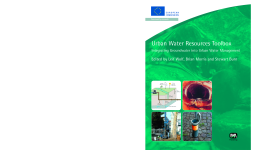
Additional Information
Book Details
Abstract
Holistic but applicable approaches are urgently needed to help plan long-term, cost-effective and sustainable urban water management systems. Groundwater is a central element in the urban water cycle of all cities located on aquifers, yet it remains inadequately integrated into urban water management practices.
This book describes holistic approaches for quantification and balancing of urban water and solute fluxes that have been developed by the joint Euro-Australian research project AISUWRS. The new tools comprise a chain of interconnected models that link urban water supply, urban drainage and urban groundwater resources. These include a new sewer exfiltration, model that is based on pipe asset conditions which permits flows to the environment to be estimated.
The book provides details on the further processing of this information through the unsaturated zone down to aquifer, where numerical groundwater flow and transport models are applied. Concise documentation is provided on each of the models. The practicability of applying the chain of models was tested by applying it in four case study cities in Australia, Germany, Slovenia and the United Kingdom that have diverse conditions in terms of hydrogeologic setup, climate and data availability. This permitted additional validation by field investigations, including problem-oriented monitoring campaigns aimed at assessing the impact of wastewater practice on groundwater.
The book provides guidance and examples of the application of multilevel piezometers, on adapted monitoring strategies, and the use for interpretation purposes of microbiological parameters, pharmaceutical residues and related marker species. The socio-economic analysis in the case study cities sometimes uncovered distinctively different problem perceptions and priorities, both in the groups of experts responsible for the water management and with the remaining stakeholders. The AISUWRS project has developed tools to foster these urgently required deliberation processes. Methodologies for formal sustainability assessment with a triple bottom line background were also elaborated and tested during the case studies. The case studies have shown that the approach is valid and constitutes an important step towards integrated urban water management.
Table of Contents
| Section Title | Page | Action | Price |
|---|---|---|---|
| Contents | vi | ||
| Dedication | vii | ||
| Foreword | viii | ||
| AISUWRS team members | x | ||
| Summary | xi | ||
| 1. Introduction | 1 | ||
| 1.1 Problems in urban groundwater management | 1 | ||
| 1.2 The AISUWRS approach | 8 | ||
| 2. The Models | 15 | ||
| 2.1 Urban Volume and Quality | 16 | ||
| 2.2 Network Exfiltration and Infiltration Model (NEIMO) | 34 | ||
| 2.3 Contaminant transport through the unsaturated zone: The SLeakI and POSI models | 51 | ||
| 2.4 Simple approach for balancing transient unsaturated soil processes in urban areas by the analytical model UL_FLOW | 60 | ||
| 2.5 Numerical Urban Groundwater Modelling using FeflowTM / ModflowTM HACCP approach to ground water modelling | 73 | ||
| 2.6 Integrating it all: the decision support system | 91 | ||
| 3. Application to real world problems | 100 | ||
| 3.1 A matrix-flow aquifer: Rastatt, Germany | 100 | ||
| 3.2 A sandstone aquifer: Doncaster, UK | 144 | ||
| 3.3 A layered aquifer system: Ljubljana, Slovenia | 191 | ||
| 3.4 A karstic aquifer system: Mt Gambier, Australia | 217 | ||
| 4. Socio-Economics and Sustainability | 251 | ||
| 4.1 Objectives, scope and approach | 251 | ||
| 4.2 Guidelines for data collection and analysis – the SEESAW Model | 257 | ||
| 4.3 Executive summary of the model applications in the case study cities | 273 | ||
| 5. AISUWRS Urban Water Resources Toolbox – A Brief Summary | 282 | ||
| 6. References | 291 |
